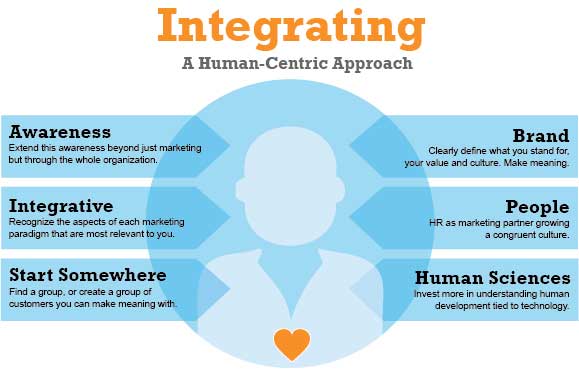In July 2011, I wrote about an emerging marketing paradigm called "human-centric marketing" and how it represents an exciting evolution of today's customer-centric approach to marketing.
"Human-centric marketing is defined by brands [that] approach engaging their current and prospective customers via advertising and marketing tactics as whole human beings with hearts, minds, and spirits," writes Philip Kotler, author of Marketing 3.0.
In this article, I will outline the following six implementation steps that lead to a human-centric approach to marketing:
- Gain awareness.
- Become integrative.
- Start somewhere.
- Identify what your brand stands for.
- Consider your people.
- Understand human sciences.
1. Gain awareness
Once you are aware of what the human-centric approach to marketing is, you'll be ready to build a brand-marketing ecosystem that embraces all of your stakeholders—from customers to employees, and community members.
A handful of brands—such as Whole Foods, Patagonia, and Zappos—have begun to embrace a human-centric approach to marketing, and we can envy their ability to form deep, meaningful connections with their customers.
Their way of doing business aligns with what consumers want; as a result, those brands are bound to be successful in the long run. In fact, the cumulative annualized return of "conscious" businesses' stocks was nine times that of the S&P 500 (1026% vs. 122%) over the ten-year period ended June 2006, according to an empirical study of "Conscious Capitalism," as reported in Firms of Endearment, published by the Wharton Business School.

2. Become integrative
Human-centric marketing is integrative by nature; after all, it evolved from the most relevant traits of customer-centric and brand-centric marketing.
Companies that will succeed in the next era of marketing will be those that build their brands around a deep and meaningful purpose and address customers as human—a totality of mind, body, and spirit.
The challenge for many of us, however, is that we are not quite comfortable talking about the human spirit, and our left brain keeps pushing us toward wanting to quantify and measure everything. So be prepared: As you take a more human-centric approach, you will need to shift from category understanding to deep human understanding.
3. Start somewhere
Finding a starting point is not always easy. Obviously, you cannot connect with each customer in a deep and meaningful way, but you can start to do so with a group of customers who share a bond with your organization.
And, over time, those customers may become your best marketing media.
4. Identify what your brand stands for
Figure out what you stand for as a brand. Doing so is a million times easier said than done!
Even if you are not a "passion" brand, you can still create valuable relationships with your customers. By clearly and unabashedly standing for something, meaning can be shared.
Go beyond the marketing department and look to the whole brand ecosystem—your employees, customers, owners, and community—to be on board. When all those people come together, they become bonded in meaning... and the entire brand then resonates with congruence.
5. Consider your people
Your company's brand is in no small way the whole that's greater than the sum of its parts. Increasingly, the "parts" are your employees—what they stand for, what they do, and what values they hold.
Companies should aspire to build a diverse, open, and integrated culture that stands for something employees can rally around and support.
According to Tony Hsieh, CEO of Zappos, "Many companies have core values, but they don't really commit to them. They usually sound more like something you'd read in a press release. Maybe you learn about them on day 1 of orientation, but after that it's just a meaningless plaque on the wall of the lobby."
So, commit to your values, your culture, your employees—and the brand will follow.
6. Understand human sciences
Customers are rapidly taking control of media and placing greater demand on marketers to engage them via one-to-one marketing dialogue. A human-centric approach to marketing requires that you think deeply about the users you serve, understand their informational needs, consider the scenarios in which they're likely to seek out your brand or interact with your information, and contemplate their typical behaviors outside of those specific scenarios.
As an exercise, try thinking of your customers as if they were your products—the raison detre of your business. Now, more than ever, brands must understand and optimize every interaction with customers in a way that establishes positive, emotional responses. You have your humanity in common with your customers, and your shared experiences are the true calling card of your brand.

* * *
Taking a human-centric approach, developing insights into your customers' needs and wants, and understanding what motivates (or demoralizes) them requires effort and investment.
Paul Kirwin, founder of SwarmBuilder, said it best: "Don't sell them stuff. Sell them on themselves. And that's humanity. And that is real."
I look forward to hearing your perspectives, as we all participate in and learn from this new and unfolding marketing paradigm.



